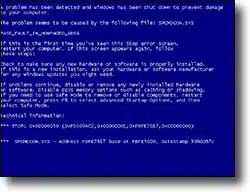Blue screens can happen for a variety of reasons. These days, driver issues are probably number one on that list, tied with problems at shut down.
Gathering information
First, it’s an excellent idea to take a picture of the blue screen. It’s a good way to get the information to someone who can help, or just to have available to look at later as you’re researching the problem yourself.
I would start with trying to identify the driver that’s involved. That’s most likely going to be based on the name of the file that was referenced in the blue screen. If the name of the driver is not obvious from the file name, I would Google it. Hopefully, that will at least lead you to the specific hardware that’s involved in this problem.
Check hardware

If the hardware isn’t being used and it’s removable, I’d be really tempted to take it out, at least for a while. That way you can see if the problem goes with it. Next, I’d make sure you have the latest drivers for that hardware. If it’s an add-on component, that means going to the manufacturer’s website for the latest drivers. If it’s a basic system component, I’d check next with the computer manufacturer itself.
Get up-to-date
And finally, I’d make absolutely certain that Windows itself is up to date and that any possible optional driver updates offered by Windows update are installed.
If all that fails, I’d probably find a good technician.
There’s a small possibility that it’s a software issue and that a reinstall of Windows would actually fix it, a small possibility.
Of course, if it is, in fact, a hardware problem, a reinstall isn’t going to help you at all. Finally, if you changed or added hardware lately, that’s always very high on the suspect list.

You could get some idea from the ‘STOP’ error message number at the bottom of the blue screen. Note down the number and look up at the following microsoft site for an explanation. http://msdn.microsoft.com/en-us/library/aa126132.aspx
Now, that’s a helpful article! I wish more were as precise and informative as this one. In fact, this really helps in my understanding of what goes on during bsod’s and what I need to do to resolve it, even in prioritized steps. I now have an easy plan of action to tackle the issue. Thank you for your work, Leo.
This article with responses reinforces my joy in switching to a Chromebook two years ago for trouble free computing.
hello guys can you help me out. my laptop is shutting down suddenly showing blue screen the moment it starts. I just add 4 GB ram on one slot 2GB on another slot but previously it had 2GB. b/c of this frequent shutting down I lost my hard disk. please tel me what to do!